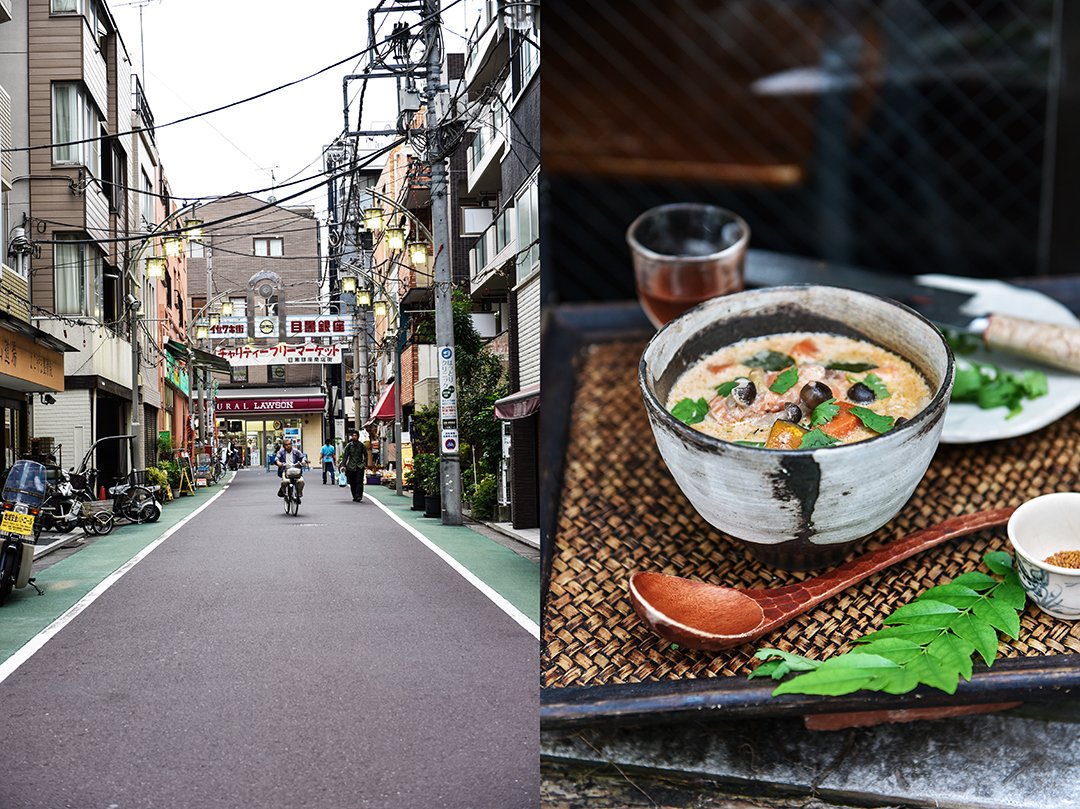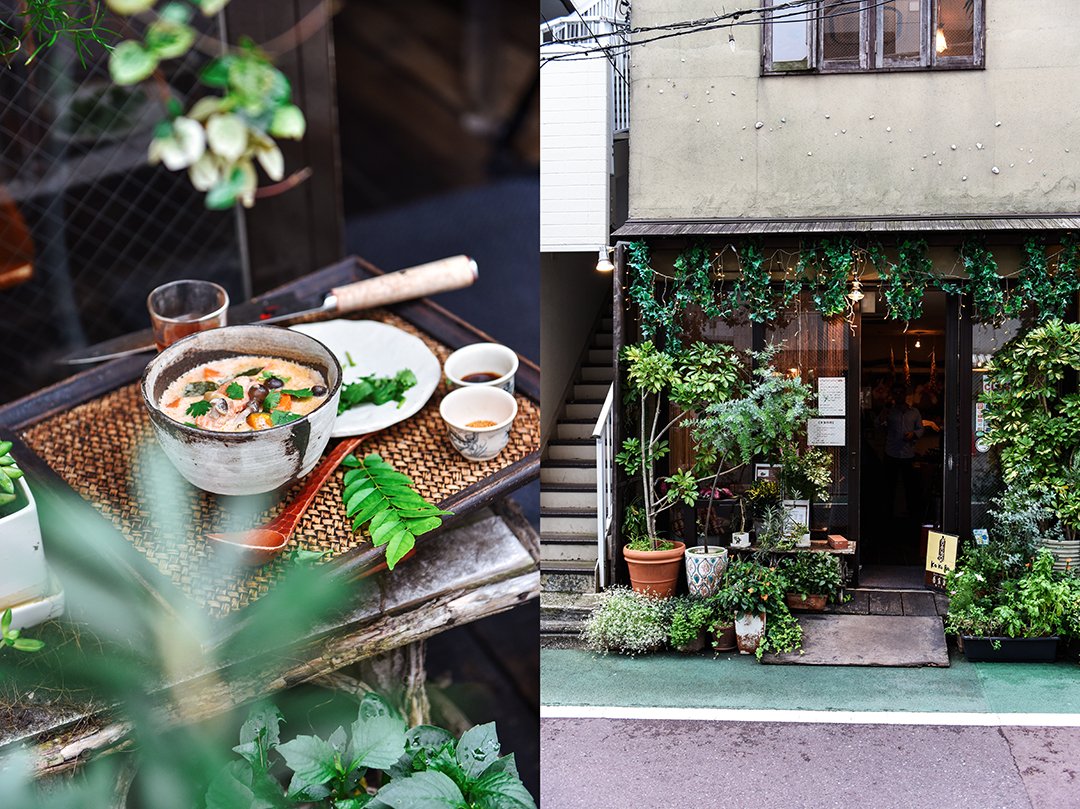Meet In Your Kitchen | Masako Imura's White Curry in the Heart of Tokyo
It's quite a surreal scene that Chef Masako Imura chose for her acclaimed Kakura restaurant: classical music playing in the street from invisible loudspeakers, no cars, but people riding bicycles or walking slowly listening to the gentle harmonies filling the city's warm air. We're in Tokyo, right in its vibrant heart, however, the peaceful scenery, the narrow house where the restaurant sits snugly speaks a different language. The green facade covered in ivy and sparkling little lights, pots of flowers, herbs, and leafy plants arranged in front of the restaurant's window, create a vivid contrast to the city's monotonous grey. Aromatic mint, basil, rosemary, and curry leaves grow right at the chef's doorstep ready to be brought into the kitchen and turned into complex spiced dishes.
The outside couldn't suit the inside any better, it's a green oasis created for a restaurant that celebrates Japanese curry based on the old knowledge of Chinese medicine. Masako Imura's creations are rich, colorful, and delicious. Her Kakura Curry, Black Curry, her seasonal vegetable, or fish curries are a pure pleasure to eat and caress and activate different parts and functions of the body. The nutritionist follows a holistic philosophy, in which mind and body, people and nature complete each other in harmony. The ingredients that she uses are organic, regionally and seasonally sourced, the chef knows how to treat each vegetable with respect and creativity. It's about healthful food that gives you energy rather than taking it away from you.
Fans from all over world, many artists and musicians, love her beautiful cuisine, all those fascinating flavors that Masako brings to the table at her cozy restaurant that she opened in 2005. The food warms up your soul. When you get a chance to meet her in her kitchen for a few hours to chop and chat, and peek into her pots and pans, you get a glimpse of this universe that makes her creations so unique and special. Spices are her most important tool, the heart of every composition. She works with perfectly balanced curry mixtures, individually put together for each dish, like in the fish curry that she shares with us. The warming fragrance of mustard seeds and curry leaves sizzling in hot oil are the start, the tempting invitation, before the other parts follow to add more depth: Nam Pla (fish sauce), shrimp paste, ginger, and colorful spices, which she attentively arranges in little bowls next to the cooker. Lotus root, sticky Japanese potato, golden pumpkin and carrot, and various mushrooms lend freshness and flavors to a creamy sauce full of heat.
The love for the kitchen lies in the family, Masako Imura's mother taught her daughter how to cook and use food for more wellbeing. Masako was the youngest, but physically the weakest, her mother paid a lot of attention to her girl's diet. Nourishing, natural, and rich, using Chinese medicinal cuisine, it helped her to become the strong and inspiring woman that she is today, loved for her curry creations at the Kakura restaurant.
In the next months, I’ll share many new Meet In Your Kitchen features with you that took me to California, Italy, France, and Japan. Thanks to Zwilling for sponsoring these features for our culinary trip around the world!
Autumn White Curry with Salmon
By Masako Imura
Serves 3-4
3 tablespoons rapeseed oil
1 tablespoon mustard seeds
8 curry leaves
100g / 3.5 ounces onion, cut into 1 cm / ½ inch cubes
60g / 2 ounces radish, cut into 1 cm / ½ inch cubes
60g / 2 ounces carrot, cut into 1 cm / ½ inch cubes
100g / 3.5 ounces shimeji mushrooms, shredded
3-4 fresh cayenne peppers, finely chopped
1 tablespoon grated ginger
1 tablespoon grated garlic
40g / 1.5 ounces shrimp paste
1 teaspoon salt
1 teaspoon fish sauce
1 teaspoon garam masala
1 teaspoon ground coriander
1 teaspoon ground cinnamon
1 teaspoon ground cardamom
1 teaspoon garlic powder
1 tablespoon coconut flour
1 tablespoon almond flour
5 g sweet radish root
500ml / 2 cups water
800ml / 3 1/3 cups milk
30g / 1 ounce lotus root, cut into 1 cm / ½ inch cubes
60g / 2 ounces yam, cut into 1 cm / ½ inch cubes
90g / 3 ounces pumpkin, cut into 1 cm / ½ inch cubes
10g / 1/3 ounce white cloud ear mushroom, soaked in water
300g / 10 ounces salmon filet, cut into bite size pieces
Boiled white rice, for serving
A handful fresh coriander leaves, for serving
In a large pot, heat the oil, mustard seeds, and curry leaves over medium-high heat for about 15 seconds or until the seeds start popping. Add the onion, radish, carrot, and shimeji mushrooms, turn the heat down to medium and sauté, stirring once in a while, until soft.
Stir in the cayenne peppers, ginger, garlic, shrimp paste, salt, and fish sauce and cook for 1-2 minutes; then add the garam masala, coriander, cinnamon, cardamom, garlic powder, coconut powder, almond powder, and sweet radish root, stir and cook for 1 minute.
Pour in the water and milk, bring to a boil, and cook, uncovered, for about 20 minutes over medium heat. Add the lotus root, yam, and pumpkin and cook for about 5 minutes or until soft. Gently stir in the white cloud ear mushroom and salmon and cook for 5 minutes or until the salmon is cooked through; season with salt to taste.
Divide the rice and curry between bowls, sprinkle with fresh coriander, and serve immediately.
What is your most cherished childhood memory in the kitchen?
I couldn't eat carrots, so every day my mum would mash them up so they were easier for me to eat. Every single day without fail. Now I love them.
How old were you when you decided to become a chef?
It was actually quite late, I was 25. Actually, I used to be a cooking instructor, but I was 25 when I wanted to work in a real restaurant as a chef.
What makes Japanese cuisine so special?
It has to be the culture of using dashi. Western cuisine uses stock but in Japan we use kelp and bonito and have the custom of using dashi instead. Staple Japanese food will almost always harness dashi, giving them a subtle undertone of flavour. I would say that's what makes Japanese cuisine special.
What kind of dashi do you use in your restaurant?
I use dashi made from kelp and dried shiitake mushrooms.
Which role does curry play in Japanese cooking?
I would say it's similar to Japanese miso soup, each family will have their own curry. Mum's curry will always taste like mum's curry. We've always had miso soup, but lots of Japanese people say their favourite curry is their mum's curry. But each Japanese family will have their own Japanese curry. Normally.
Do you have a close relationship with the suppliers of your restaurant?
There are suppliers I'm close to and those I'm not so close to, but I buy products from them because I trust them, because they're people I know.
Are organic and local products important to you?
Very, very important!
Is there a rising interest in Japan for organic food?
It’s incredibly popular.
Do you think that the people - over the last few years - became more critical with their food?
I've found that lately more and more people are concerned about their health, and so I've been getting a lot more customers who express interest in organic and chemical free food, as well as cuisine that incorporates Chinese medicine.
What fascinates you about Chinese medicine?
The more I learn about Chinese medicine the more it makes sense, so I study more and more. Of course, each person is different so I have to learn what that means. There are things that will work for someone but not for others, so I diagnose each individual and carefully select the Chinese medicine that works best for them. I love it that, what each person has to eat, is always going to be different.
Where did you learn about Chinese medicine?
I studied at the Japanese branch of the Beijing University of Chinese Medicine.
What made you so interested in Chinese medicine?
I'd have to say it was when I was young, my mum used natural things. She actually used natural Chinese medicine more than conventional medicine. Well, we went to the doctors when we were sick, but if we had to take medicine, had to put something in our bodies, we took Chinese medicine. Yeah, that was it. Ever since I was really small, we went to a Western hospital for treatments, but if we had to take anything she always used these really old, traditional Chinese medicines because she thought they were safer. That's how I was brought up. Then I learned a little about macrobiotics and all sorts of other things. But it wasn't because I thought "people have to eat these", it was because each person's biological makeup is different. And so, I started to make food using Chinese medicine for individuals to match their individual makeup. I slowly realized that I didn't just have an interest in this, that this was real cooking. There are foods that can be good for certain people but not good for others. There are all kinds of medicinal diets that are good, but finding the right ones for each person can be a challenge.
What's the clients’ feedback? Do the people come because they want healthy food? Or do they just come because they find it's delicious?
I think they come because it's delicious and healthy. Because they want to be healthy in a delicious way.
What's your association with the cherry blossom season?
It's the season students start the new school year so it's seen as the season of new beginnings. It makes me feel really optimistic. This area here called Nakameguro is famous for a lot of cherry blossoms, it's also called a town of cherry blossoms.
Can you use the blossoms for your cooking?
Yes, I use them a lot. I put them into the rice, ice cream, and pudding. The ingredients I use will vary depending on the season, but they're all good for you.
Thank you very much, Masako Imura!












